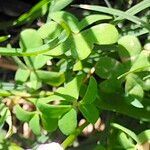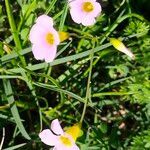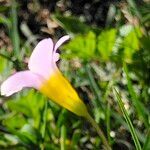Rather weak, usually 15-20 cm high, almost glabrous or very, sparsely pubescent, stemless or rarely with a very short stem. Bulb ovoid, about 1-5 cm long, more or less beaked at the apex, with brown outer tunics. Rhizome slender with a few small amplexicaul scales. Leaves 2-20, basal or apically congested on a very short stem, more or less erect; petioles usually 2-5 cm long; leaflets 3, with very short villoso-pubescent petiolules, widely triangular, bilobed to about the middle or less, sometimes sparsely pilose below, 0.5-1 cm long, 0.5-1.5 cm broad, the lobes more or less obliquely obovate, obtuse, the sinus broad or narrow. Peduncles 2-4-fld., basal or very rarely lateral on a short stem, often twice as long as the leaves; bracts subulate, callose at the apex; pedicels 2-5 cm long, like the sepals, glabrous, sparsely pubescent or rarely glandular-pilose. Sepals broadly lanceolate, 4-5 mm long, with 2 small orange apical calli. Corolla glabrous, 1.3-1.9 cm long, pale violet or rarely white, with a widely funnel-shaped pale greenish tube; petals cuneate, rounded at the apex, 5-7 mm broad. Filaments, the shorter 1.5-3.5 mm, usually glabrous, the longer 3.5-5.5 mm long, minutely glandular-pilose, edentate. Ovary pilose on the upper half, the chambers 8-9-ovuled; styles pubescent. Capsule elongate, exserted. Seeds endospermous.
Slender, acaulescent geophyte, up to 0.2 m high. Bulbs ovoid, with apical beak, brown. Leaves basally congested, trifoliolate, leaflets widely triangular, bilobed to middle. Peduncles 2-4-flowered. Flowers light pink (rarely white) with greenish tube. Flowering time Apr.-June.
Small, weak geophyte, stem absent or very short. Leaves terminal, trifoliolate, bilobed to middle. Flowers 2-4 per peduncle, pale lilac or white with greenish tube.



